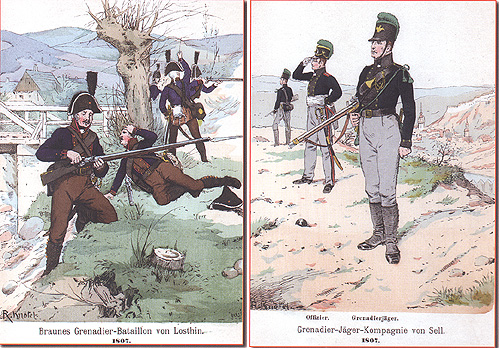Regulating Battalions: The Prussian Way
Introduction
by Jeff Lewis, UK
| |
A popular, and by now hopefully rather outdated, view is that in the late eighteenth century the Prussian army rotted from within ignoring further developments in the military arts. The antics of Saldern consuming much time and effort over which of two march speeds, a mere one step per minute in difference, was the most effective, are often retold as a symptom of everything that was wrong with the Prussian army. The shattering of the Prussian army in 1806 has previously been put across as a catastrophic watershed only after which consideration of reform took place, the new modern Prussian army emerging in 1813 having adopted wholesale the French principles of war. In actual fact the Prussian army always contained a number of forward looking men of high rank and many of the reforms seen together in 1813 were already in hand before the fateful battles of 1806. This is most clearly the case with that of the Brigade formations. The history of improvements in the military art during the eighteenth century is more one of improvements in the sophistication and professionalism of the command within armies than one of changes in technology. Much of what was seen in Napoleonic times was technologically achievable nearly a hundred years before, but the human command systems were previously not sufficient to cope. The major problem with lack of sophistication in command was the need to keep armies fairly small and their manoeuvres simple, cavalry on the wings with the infantry in two (or more) lines in between was a simplification most easily handled by a small command. The weakness in such simple systems were that they were not very flexible and smaller parts of the army were less able to cope with any problems they faced without dragging the rest of the army into the same delays and retro grade movements. The most obvious way was to create mini armies of which a large army would be made up, where each of the mini armies could handle its own problems to a reasonable degree and each ones delays need have less effect on their neighbours. Such formations with a mixed force of all arms was in discussion well before 1806 within Prussia; being put forward in a formal discussion paper in 1801. The implementation of the idea did not come until 1806, just as the army was marching to war. With the hindsight gifted to armchair warriors it is quite easy to note that this reform would probably have been better left until the army had had some time to adjust and knock the kinks out of the new system. Some of the problems for the Prussians in the ensuing battles can be seen as due to a lack of cohesion within the different parts of the new structures, rather than an adherence to ‘linear’ tactics. These problems were mainly addressed by laying out clearly and exactly how a Brigade was arranged and how its separate troops cooperated together, not merely as a pamphlet to Brigade commanders, but written straight into the Infantry Regulations every officer in the army was to carry. Here was regulated where each battalion stood, its distance from each other, and even its formation. In any future war the Prussian officers could be in no doubt where their particular unit was supposed to be, who it was to follow, and its role in the Brigade. The Plates and explanation following are taken directly from the Prussian Infantry Regulations of 1812. Regulating Battalions: The Prussian Way Back to Table of Contents -- First Empire # 78 Back to First Empire List of Issues Back to MagWeb Master Magazine List © Copyright 2004 by First Empire. This article appears in MagWeb.com (Magazine Web) on the Internet World Wide Web. Other articles from military history and related magazines are available at http://www.magweb.com |
 Frederick the Great, for better or worse, is credited with bringing
linear warfare to its perfection in the mid eighteenth
century and laying down the principles on which most other
European trained armies exercised their Infantry.
Frederick the Great, for better or worse, is credited with bringing
linear warfare to its perfection in the mid eighteenth
century and laying down the principles on which most other
European trained armies exercised their Infantry.